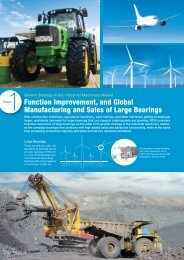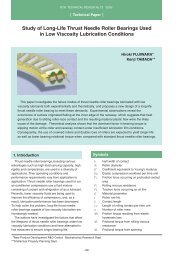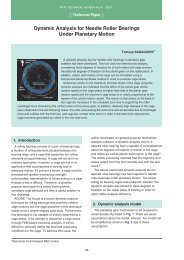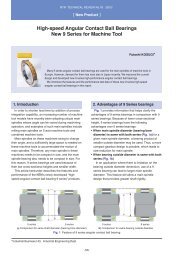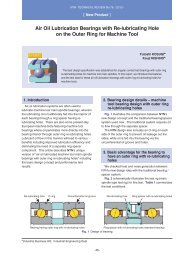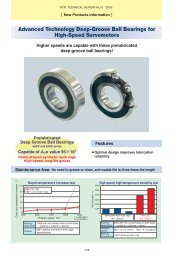Special Issue; Products for Industrial Machinery - NTN
Special Issue; Products for Industrial Machinery - NTN
Special Issue; Products for Industrial Machinery - NTN
You also want an ePaper? Increase the reach of your titles
YUMPU automatically turns print PDFs into web optimized ePapers that Google loves.
<strong>NTN</strong> TECHNICAL REVIEW No. 742006<br />
Use of oil is effective to decrease the friction<br />
coefficient. Until now, <strong>NTN</strong> had been attempting to<br />
lower the friction coefficient <strong>for</strong> sliding bearings by<br />
using an oil dispersion technique with a polymer alloy,<br />
<strong>for</strong> example. 3)<br />
However, conventional techniques had limitations<br />
because the addition of an excessive amount of oil<br />
can lead to deterioration in the mechanical strength<br />
and <strong>for</strong>mability of a sliding material. There<strong>for</strong>e, we<br />
developed a technique that adopted porous silica as<br />
an oil retaining material (oil-impregnated silica).<br />
Thereby, we attempted to increase the content of oil<br />
included in the resin while maintaining good<br />
mechanical characteristics and <strong>for</strong>mability of the<br />
resultant sliding resin material. 4)<br />
Compositions and frictional characteristics of<br />
materials prepared by blending different proportions of<br />
oil-impregnated silica into ultrahigh-molecular-weight<br />
polyethylene (UHMWPE) are summarized in Table 1<br />
and Fig. 3. Compared with the material blended with<br />
oil alone 2, the material blended with oil-impregnated<br />
silica 3 exhibited a lower dynamic friction coefficient<br />
though its oil content was equal to that of material 2.<br />
With an increase in the amount of oil-impregnated<br />
silica (material 4), the dynamic friction coefficient<br />
further decreased, reaching a level lower than a third<br />
the level obtained with a PTFE-based sliding material.<br />
Having undergone the test, the sliding surface of<br />
material 4 was inspected, and the oil-impregnated<br />
Table. 1 Composition of test specimens <strong>for</strong> sliding tests<br />
Material<br />
1<br />
2<br />
3<br />
4<br />
Composition (vol%)<br />
UHMWPE (100)<br />
UHMWPE (85)Silicone oil (15)<br />
UHMWPE (82)Oil-impregnated silica (18)<br />
UHMWPE (70)Oil-impregnated silica (30)<br />
1:5 porous silica to silicone oil ratio<br />
silica exposed on the sliding surface was found as a<br />
result (Fig. 4). In addition, the static oil seepage from<br />
material 4 at room temperature and 15 MPa conditions<br />
was measured. As shown in Fig. 5, the oil seepage<br />
increased as the time elapsed and reached 6% in 100<br />
hours. Assuming that only the oil near the surface layer<br />
seeped out this level of leakage is too great.<br />
From these findings, we estimated the low friction<br />
mechanism of this material as shown in Fig. 6. In<br />
other words, we believe the following theory about the<br />
mechanism. Since the oil-impregnated silica serves as<br />
the load bearing point, solid-to-solid contact is<br />
inhibited, making it easier <strong>for</strong> an oil film to <strong>for</strong>m.<br />
Seepage wt%<br />
Fig. 4 Surface of the material 4 after sliding test<br />
8.00<br />
6.00<br />
4.00<br />
2.00<br />
Pressure: 15 MPa<br />
Room temperature<br />
Oil-impregnated<br />
silica<br />
10m<br />
0.00<br />
0<br />
20 40 60 80 100<br />
Time h<br />
Fig. 5 Relationship between loading time and oozed oil<br />
amount from the material 4<br />
Dynamic friction coefficient<br />
0.30<br />
0.25<br />
0.20<br />
0.15<br />
0.10<br />
0.05<br />
0.00<br />
Two test runs<br />
UHMWPE<br />
100%<br />
UHMWPE<br />
15%<br />
silicone oil<br />
Test rig: oscillating ring-on-disk<br />
Specific pressure: 15MPa<br />
Velocity: 0.1m/s<br />
Counterpart material: SUS304 (Ra 0.1m)<br />
Characteristic to be measured:<br />
dynamic friction coefficient 5 minutes later<br />
Silicone oil added<br />
Porous silica added<br />
Increased amount added<br />
UHMWPE<br />
3% porous silica<br />
15% silicone oil<br />
UHMWPE<br />
5% porous silica<br />
25% silicone oil<br />
PTFE<br />
Oil film<br />
Resin material<br />
Transfer of oil<br />
Counterpart material<br />
Oil-impregnated<br />
porous silica<br />
Operating mechanism of oil-impregnated silica (estimated)<br />
Load-bearing point – decrease in true contact area<br />
Oil supply source – decrease in shear strength<br />
Low <br />
Fig. 3 Friction properties of the materials filled with oilimpregnated-silica<br />
Fig. 6 Estimated mechanism of low friction of the<br />
developed material<br />
-110-




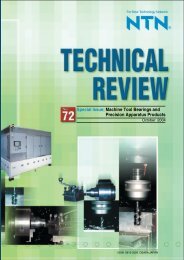
![[New Product] Unit Products for Office Equipment - NTN](https://img.yumpu.com/27154451/1/184x260/new-product-unit-products-for-office-equipment-ntn.jpg?quality=85)
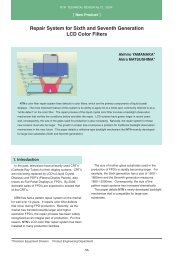
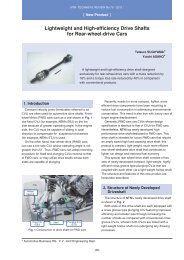
![[New Product] Development of Oil-impregnated Sintered ... - NTN](https://img.yumpu.com/27154427/1/184x260/new-product-development-of-oil-impregnated-sintered-ntn.jpg?quality=85)

